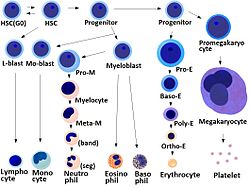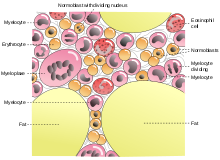خلية جذعية مكونة للدم
| خلية جذعية مكونة للدم | |
|---|---|
 HSC=Hematopoietic stem cell, Progenitor=Progenitor cell, L-blast=Lymphoblast, Lymphocyte, Mo-blast=Monoblast, Monocyte, Myeloblast, Pro-M=Promyelocyte, Myelocyte, Meta-M=Metamyelocyte, Neutrophil, Eosinophil, Basophil, Pro-E=Proerythroblast, Baso-E=Basophilic erythroblast, poly-E=Polychromatic erythroblast, Ortho-E=Orthochromatic erythroblast, Erythrocyte, Promegakaryocyte, Megakaryocyte, Platelet | |
| Details | |
| Identifiers | |
| اللاتينية | cellula haematopoietica precursoria |
| MeSH | D006412 |
| TH | TH {{{2}}}.html HH2.00.01.0.00006 .{{{2}}}.{{{3}}} |
| المصطلحات التشريحية | |
الخلايا الجذعية المكونة للدم ( HSCs)، كما وردت" الخلايا الجذعية لدم ، هي multipotent الخلايا الجذعية ذات قوة متعددة التي تؤدي إلى تخليق كل أنواع الخلايا من دم في الدم النخاعي (حيدات و الضامة ، العدلات ، الأسسة ، الحمضات ، الكريات الحمراء ، megakaryocytes / الصفائح الدموية ، الخلايا الجذعية) ، و الليمفاوية الأنساب (الخلايا التائية ، الخلايا البائية ، خلايا NK). وقد خضعت لتعريف الخلايا الجذعية للدم تنقيح كبير في العقدين الماضيين. الأنسجة المكونة للدم تحتوي على خلايا ذات قدرات التجدد طويلة الأجل وقصيرة الأجل والتي وسمت multipotent ، oligopotent ، و unipotent الأسلاف. HSCs 1:10.000 تشكل الخلايا في النسيج النخاعي.
الخلايا الجذعية المكونة للدم تمثل تعدادا غير متجانس . ثلاثة أنواع من الخلايا الجذعية موجودة, تتميز بنسبتهم بمحتواها الليمفاوى لأسلافهم من نخاع العظم ذرية (L / M) في الدم. المنحازة للنخاع (My-bi) خلية جذعية مكونة للدم لديها L / M نسبة (> 0، <3) ، في حين أن الخلايا اللمفاوية المنحازة (لي ثنائية) HSC تظهر نسبة كبيرة (> 10). الفئة الثالثة تتكون من خلايا جذعية مكونة للدم (بالا) المتوازنة التي ≤ 3 L / M ≤ 10. حاليا هناك الكثير من العمل يجري الاضطلاع به للتحقيق في خصائص هذه الفئات المختلفة من الخلايا الجذعية المكونة للدم ، ولكن يبدو أن الخلاياالمنحازة فقط للنخاع والمتوازنة هى دائمة HSCs و ذاتية التجدد . بالإضافة إلى ذلك ، أظهرت التجارب زراعة السلالات المتسلسلة أن كل سلالة لها وضع تفضيلي لإعادة تخليق نوع من الخلايا في توزيع الدم، مما يوحي بوجود برنامج لاجيني موروثة لكل نوع فرعي.
الخلية الجذعية المكونة للدم إنگليزية: Hematopoietic Stem Cell هي خلية جذعية بالغة لها القدرة على التمايز إلى جميع أنواع خلايا الدم (خلايا حمراء وخلايا بيضاء بجميع أنواعها وصفائح دموية). يتم الحصول على هذه الخلية من نخاع العظم وتأخذ عادة من عظم الفخذ أو عظمة القص.
المصدر
HSCs are found in the bone marrow of adults, which includes femurs, hip, ribs, sternum, and other bones. Cells can be obtained directly by removal from the hip using a needle and syringe, or from the blood following pre-treatment with cytokines, such as G-CSF (granulocyte colony-stimulating factors), that induce cells to be released from the bone marrow compartment. Other sources for clinical and scientific use include umbilical cord blood, peripheral blood a small number of stem and progenitor cells circulate in the bloodstream, in the past 10 years, researchers have found that they can coax the cells to migrate from marrow to blood in greater numbers by injecting the donor with a cytokine, such as granulocyte-colony stimulating factor (GCSF)and recent study shown that ex-vivo expansion of HSCs is possible in 3D bioreactor. Because HSCs are not generated in the adult but during the embryogenesis, many scientific groups are studying HSCs during the embryonic development. It is now well described in mammalians that the first definitive HSCs are detected in the AGM (Aorta-gonad-mesonephros), and then massively expanded in the Fetal Liver prior to colonize before birth the bone marrow. Such fundamental research could help to understand the mechanisms that are responsible of HSCs generation and/or amplification, and to the discovery of new molecules that could eventually be used to maintain or expand HSCs in vitro.
LT-HSC/ST-HSC/Early MPP/Late MPP
Irving Weissman's group at Stanford University was the first to isolate mouse hematopoietic stem cells in 1988 and was also the first to work out the markers to distinguish the mouse long-term (LT-HSC) and short-term (ST-HSC) haematopoietic stem cells (self-renew-capable), and the Multipotent progenitors (MPP, low or no self-renew capability — the later the developmental stage of MPP, the lesser the self-renewal ability and the more of some of the markers like CD4 and CD135):
- LT-HSC : CD34-, SCA-1+, Thy1.1+/lo, C-kit+, lin-, CD135-, Slamf1/CD150+
- ST-HSC : CD34+, SCA-1+, Thy1.1+/lo, C-kit+, lin-, CD135-, Slamf1/CD150+, Mac-1 (CD11b)lo
- Early MPP : CD34+, SCA-1+, Thy1.1-, C-kit+, lin-, CD135+, Slamf1/CD150-, Mac-1 (CD11b)lo, CD4lo
- Late MPP : CD34+, SCA-1+, Thy1.1-, C-kit+, lin-, CD135high, Slamf1/CD150-, Mac-1 (CD11b)lo, CD4lo
مصطلحات مستعمرات وسلف الخلايا الجذعية المكونة للدم
Between 1948 and 1950, the Committee for Clarification of the Nomenclature of Cells and Diseases of the Blood and Blood-forming Organs issued reports on the nomenclature of blood cells.[1][2] An overview of the terminology is shown below, from earliest to final stage of development:
- [root]blast
- pro[root]cyte
- [root]cyte
- meta[root]cyte
- mature cell name
The root for CFU-E is "rubri", for CFU-GM is "granulo" or "myelo" and "mono", for CFU-L is "lympho" and for CFU-Meg is "megakaryo". According to this terminology, the stages of red blood cell formation would be: rubriblast, prorubricyte, rubricyte, metarubricyte, and erythrocyte. However, the following nomenclature seems to be, at present, the most prevalent:
| Committee | "lympho" | "rubri" | "granulo" or "myelo" | "mono" | "megakaryo" |
| Lineage | Lymphoid | Myeloid | Myeloid | Myeloid | Myeloid |
| CFU | CFU-L | CFU-GEMM→CFU-E | CFU-GEMM→CFU-GM→CFU-G | CFU-GEMM→CFU-GM→CFU-M | CFU-GEMM→CFU-Meg |
| Process | lymphocytopoiesis | erythropoiesis | granulocytopoiesis | monocytopoiesis | thrombocytopoiesis |
| [root]blast | Lymphoblast | Proerythroblast | Myeloblast | Monoblast | Megakaryoblast |
| pro[root]cyte | Prolymphocyte | Polychromatophilic erythrocyte | Promyelocyte | Promonocyte | Promegakaryocyte |
| [root]cyte | - | Normoblast | Eosino/neutro/basophilic myelocyte | Megakaryocyte | |
| meta[root]cyte | Large lymphocyte | Reticulocyte | Eosinophilic/neutrophilic/basophilic metamyelocyte, Eosinophilic/neutrophilic/basophilic band cell | Early monocyte | - |
| mature cell name | Small lymphocyte | Erythrocyte | granulocytes (Eosino/neutro/basophil) | Monocyte | thrombocytes (Platelets) |
Osteoclasts also arise from haemopoietic cells of the monocyte/neutrophil lineage, specifically CFU-GM.
الوحدات المكونة للمستعمرات
There are various kinds of colony-forming units:
- Colony-forming unit lymphocyte (CFU-L)
- Colony-forming unit erythrocyte (CFU-E)
- Colony-forming unit granulo-monocyte (CFU-GM)
- Colony-forming unit megakaryocyte (CFU-Me)
- Colony-forming unit Basophil (CFU-B)
- Colony-forming unit Eosinophil (CFU-Eo)
The above CFUs are based on the lineage. Another CFU, the colony-forming unit–spleen (CFU–S) was the basis of an in vivo clonal colony formation, which depends on the ability of infused bone marrow cells to give rise to clones of maturing haematopoietic cells in the spleens of irradiated mice after 8 to 12 days. It was used extensively in early studies, but is now considered to measure more mature progenitor or Transit Amplifying Cells rather than stem cells.
HSC Repopulation Kinetics
Hematopoietic stem cells (HSC) cannot be easily observed directly, and, therefore, their behaviors need to be inferred indirectly. Clonal studies are likely the closest technique for single cell in vivo studies of HSC. Here, sophisticated experimental and statistical methods are used to ascertain that, with a high probability, a single HSC is contained in a transplant administered to a lethally irradiated host. The clonal expansion of this stem cell can then be observed over time by monitoring the percent donor-type cells in blood as the host is reconstituted. The resulting time series is defined as the repopulation kinetic of the HSC.
The reconstitution kinetics are very heterogeneous. However, using symbolic dynamics, one can show that they fall into a limited number of classes.[3] To prove this, several hundred experimental repopulation kinetics from clonal Thy-1lo SCA-1+ lin- c-kit+ HSC were translated into symbolic sequences by assigning the symbols "+", "-", "~" whenever two successive measurements of the percent donor-type cells have a positive, negative, or unchanged slope, respectively. By using the Hamming distance, the repopulation patterns were subjected to cluster analysis yielding 16 distinct groups of kinetics. To finish the empirical proof, the Laplace add-one approach was used to determine that the probability of finding kinetics not contained in these 16 groups is very small. By corollary, this result shows that the haematopoietic stem cell compartment is also heterogeneous by dynamical criteria.
انظر أيضاً
الهامش
- ^ "First report of the Committee for Clarification of the Nomenclature of Cells and Diseases of the Blood and Blood-forming Organs". Amer J Clin Pathol. 18: 443–450. 1948.
- ^ "Third, fourth and fifth reports of the committee for clarification of the nomenclature of cells and diseases of the blood and blood-forming organs". Am J Clin Pathol. 20 (6): 562–79. 1950. PMID 15432355.
- ^ Sieburg, HB, Muller-Sieburg, CE. Classification of short kinetics by shape. In Silico Biol. 2004;4(2):209-17

